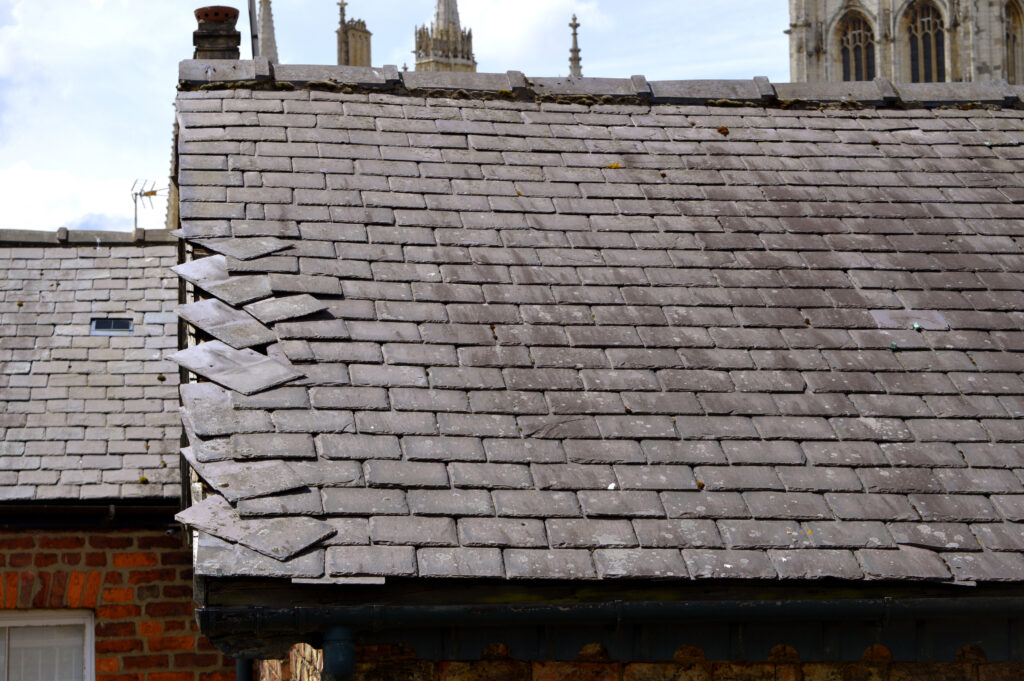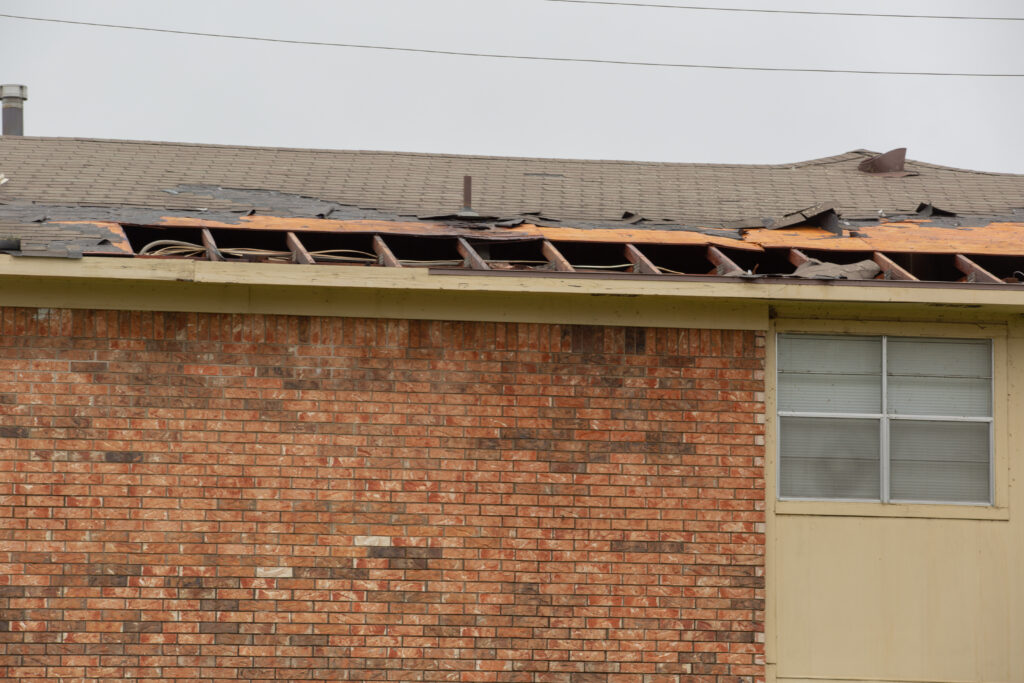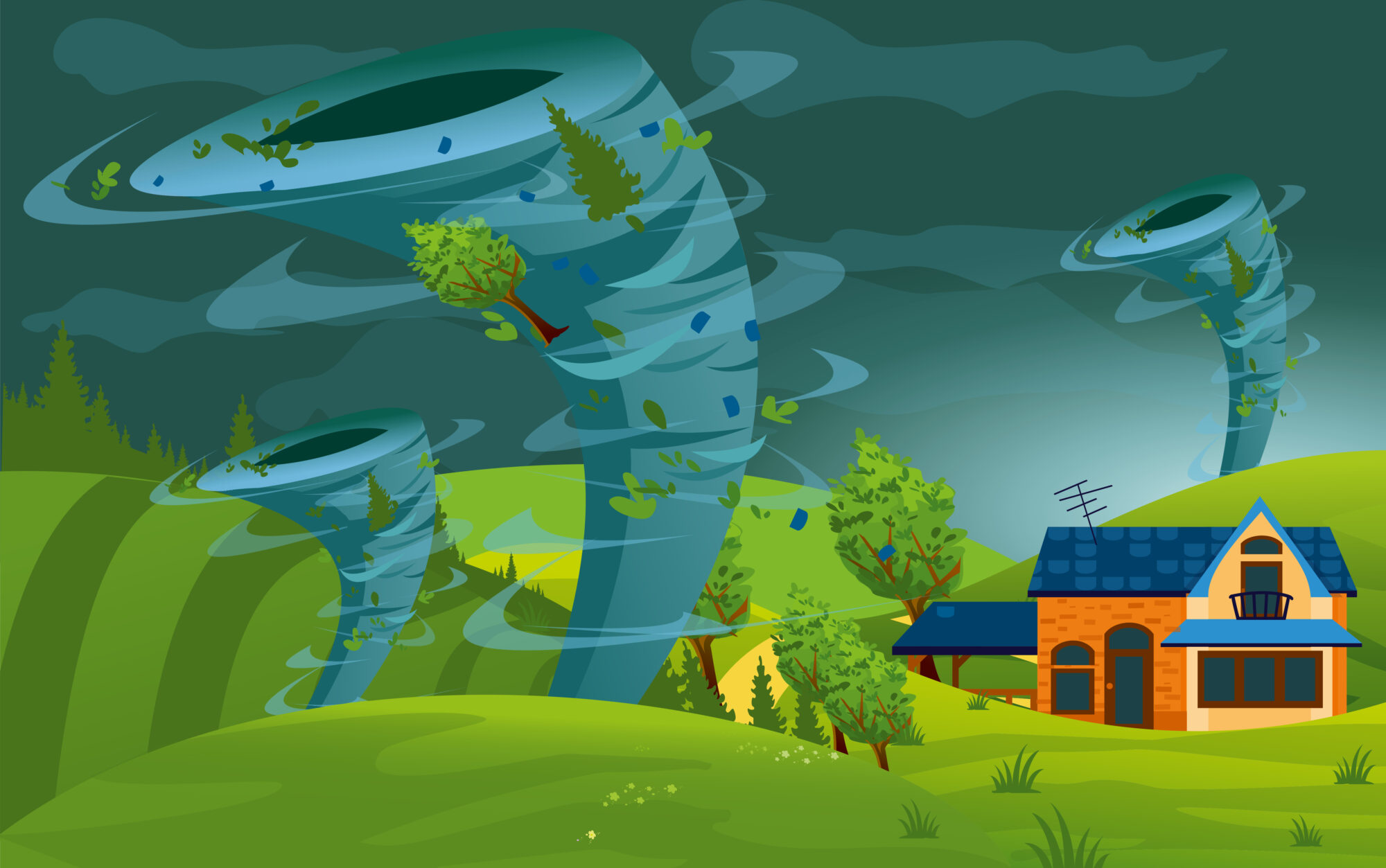Wind damage is something most people are upset about. Read this article to see why it might be a good thing!
Wind damage occurs because of a multitude of factors. We will be covering a few reasons why.

1) The Roof is Really Old
The first reason why shingles blow off is because the roof is really old. Asphalt shingles have an adhesive that holds down the shingle and is why a new shingle (if it is sealed properly) shouldn’t blow away. When the roof is really old, the adhesive gets very soft and almost liquifies. Because of that, it will spread out and get thinner with every summer season that passes by. After 10-20 years, the adhesive is really thin and won’t do what it was made to do, due to significant loss of “fatness” of the adhesive over time. At this point, if a wind comes along, it will flap the shingle tabs up and down, and then a crease will develop right below the shingle above it.
This is still considered wind damage because of the loss of granules (the little stone on top of shingles). The granules on top of shingles are there for a couple of different reasons. First-to protect the asphalt that is the main component of a shingle. The second reason is to give the shingle color. Asphalt, on its own, is broken down by UV light from the sun. If the stone covers it, it won’t break down as fast. If the wind comes by and causes a crease and the asphalt is more exposed, the shingle is technically damaged now. This is not just an idea that I came up with but is a standard in the industry and backed up by HAAG (HAAG have set the standard for what the industry considers to be “storm damage”. Their engineers’ roofing expertise is second to none. Aforementioned engineers have been forensically evaluating roofing for over 60 years, and their research/testing studies and peer-reviewed technical papers on roofing extend back to the 1960s. HAAG’s expert engineers have established cause and extent of failure or damage to industrial, commercial, or residential roofs. Their engineers will investigate damage to roofs due to design problems, construction deficiencies, excessive loading, weather and seismic events, mechanical damage, maintenance issues, and other causes. HAAG has a nearly century-long track record of analyzing damage caused by weather phenomena including: hail; snow; ice; wind; storm; surge; flooding; lightning; tornadoes; and hurricanes).
2) Not Sealed Properly
The second reason why asphalt shingles can blow off is because they didn’t seal properly. This can be because the roof was installed before or during cold temperatures, and a wind came by soon after and dislodged them. This is a monster problem when installing roofs in the late fall and winter months, when not using a cold weather installation process (we will release an article about “Cold Weather Installation” closer to the winter months). This is one problem that might cause issues at a later point in time because the roofs installed in the colder temperatures have a tendency of getting dust stuck to the adhesive strip that holds the shingle down- and then they might never seal at all!
3) Wind
The third reason why shingles blow off is because the wind in a storm is higher than what the shingles are rated for. The wind rating for shingles is tested by a 3rd party. Shingles are tested when they are relatively new; this is something that you should consider when looking at a roof that has wind damage and is supposed to have a 130 MPH wind rating. Also keep in mind that not all shingles are rated for 130 MPH wind. Most architectural shingles are rated for a 130 MPH wind, but a 3 tab shingle is usually rated for a 60-70 MPH wind. That is one reason why 3 tab shingles are notorious for blowing off as soon as the wind hits 60 mph. Something else to keep in mind when looking at wind damage on a roof is that some components of a roofing system cannot handle a 130 MPH wind. For example, 90% of cap shingles across the board only have a 60-70 MPH wind rating.
4) Improper Installation
The fourth reason is improper installation. There have been a lot of roofs that were considered damaged by the wind that were just installed improperly. They wouldn’t have handled any significant wind. This is mainly an issue when the roof is not nailed properly.

Most of the time, in an improper installation, the shingles are nailed above a .5 inch nailing line where there is a double lap on an architectural shingle. Sometimes, there are just not enough nails on a shingle. GAF, for example, states that for a 130 mph wind rating (on their Timberline Architectural shingles) you need 6-8 nails per shingle. Owens Corning will only require 4 on their Duration line due to a Sure-Nail strip that is a reinforced 1 inch strip nailing surface. Another issue that comes up a lot is that the nails will blow through the shingle if the pneumatic nail gun isn’t adjusted properly. The temperature throughout the day will change drastically, and the shingles get very soft. If the installer won’t change the setting on his tool and/or pressure in his compressor, the nails will very easily blow through the shingle; and then the shingle won’t be held at all. This happens a lot more often on 3 tab shingles because they are a single ply product.
The reason why wind damage is a good thing for some people is because- if the home has homeowners insurance- the damage might lead to a full replacement of their entire roof at no cost to them!!! This is something that sounds like it’s too good to be true. A lot of people that we came across turned down our services just because of it sounding too good to be true! Others that did get their roof replaced were shocked to see full roofs replaced at no cost to them (except their deductible). The reason you can get your roof fully replaced (if you have missing shingles) is because the homeowner’s insurance that you pay for covers damage to your roof if it is caused by an act of nature. Some home insurance policies have exclusions that don’t cover certain occurrences, but wind has never been one of them.
We have helped many people get whole roofs approved and paid for by their insurance companies. We have even negotiated on behalf of homeowners with insurance companies that initially said they wouldn’t replace the roof, but after we got involved, they agreed to cover the cost of an entire roof! Most people don’t want to admit it to themselves, but most insurance companies don’t have their clients’ best interest in mind. To think otherwise is to ignore the fact that insurance companies are for profit companies. They have share holders that they have to answer to, and on top of that, one of the big insurance companies made 3.189 Billion in 2017. So don’t worry about saving them money…
For more information, feel free to call us anytime at 585-727-8619!
We’ve got you covered!

